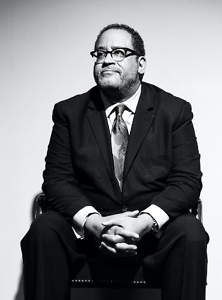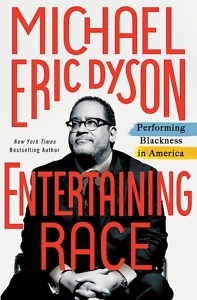Fiery and Hopeful
Michael Eric Dyson’s Entertaining Race points toward a more unified future
Michael Eric Dyson, an ordained Baptist minister and public intellectual whose books include Tears We Cannot Stop, The Black Presidency, and Long Time Coming, was recently appointed Vanderbilt University Centennial Chair and University Distinguished Professor of African American and Diaspora Studies. He also serves as University Distinguished Professor of Ethics and Society at the Vanderbilt Divinity School. Dyson’s latest book, Entertaining Race, collects a range of his work focused on the relationship of African Americans to race as performance.

By Dyson’s appraisal, Black performance of race for white entertainment began as early as 1791. He builds this theoretical framework by recounting the torture, rape, and death of an unnamed enslaved teenager, who was killed for refusing to dance sexually. Dyson asserts that aboard the slave ship Recovery, she declined “to offer mostly white men entertainment on the long journey to the Americas.” This incident, then, represents the beginnings of Black performance in the new world.
Although the book features several previously published essays, interviews, liner notes, etc., they take on a new flavor when experienced together. The sections of Entertaining Race are divided along the major locales of Black performance: “The Arts,” “Religion,” “Bodies in Motion” (sports), “The Life of the Mind” (academia), “Talk Back” (interviews), and “Publics” (protest). Each section is further portioned into more nuanced perspectives on the theme. For instance, “Bodies in Motion” considers Black performance in athletics, but later essays examine the masculinity necessary to uphold such behavior.
Throughout the book, Dyson demonstrates the impressive bandwidth of his literary abilities. He began his career as a music critic for The Hartford Advocate, and it’s refreshing to revisit such criticism in the essay “Hello Like Before.” Here, Dyson extols the lyrical skill of Bill Withers and likens his artistry to one of the most heralded Romantic poets, writing, “Withers sounds like [Alfred] Tennyson — ‘I am a part of all that I have met’ — and sings the poet’s insight in his own voice.” The essay also weaves in a sociological appraisal of Withers, suggesting that the artist transcended both racial and class boundaries. He accomplishes this, Dyson argues, by homing in on one of America’s principal fixations: love. Of course, love is far easier to feel than to convey, which is why we are so indebted to Bill Withers. Dyson concludes: “His poetry has touched the lives of millions around the globe whose tongues can barely express what their hearts so deeply feel.”
 In “Photobombing Mandela,” Dyson recounts his humorously juvenile yet admirable attempts to be photographed with the South African leader in 1990. On being in the presence of Nelson Mandela he says, “I knew I was breathing in history as I inhaled.” Dyson, having not yet established his own reputation, struggles to secure a proper photo with the iconic figure. It is by chance that he gets his desire: “Just as I bent backwards, the photographer immortalized my delirious dip. I had just photobombed the Mandelas.”
In “Photobombing Mandela,” Dyson recounts his humorously juvenile yet admirable attempts to be photographed with the South African leader in 1990. On being in the presence of Nelson Mandela he says, “I knew I was breathing in history as I inhaled.” Dyson, having not yet established his own reputation, struggles to secure a proper photo with the iconic figure. It is by chance that he gets his desire: “Just as I bent backwards, the photographer immortalized my delirious dip. I had just photobombed the Mandelas.”
He uses the metaphor of photobombing as launching point, drawing comparisons between a physical invasion of the camera’s field of view and the kind of ideological reframing that amounts to political photobombing. To this end, he discusses Ronald Reagan’s support for South African apartheid by way of vetoing any sanctions against the country. Reagan also invited South African security officers to the U.S. in an ethically questionable move. According to Dyson, the political photobombing occurred after Mandela’s death in 2013, when the Ronald Reagan Presidential Foundation and Library claimed that Reagan had decried the leader’s imprisonment. Yet, this reframing occurs on both sides. Dyson astutely notes that Mandela’s followers are also guilty of political photobombing, as they have endeavored to make him more palatable as a global figure.
More seasoned readers of Dyson’s work will not be surprised to encounter his fiery, hopeful language. Throughout the range of material here, he reappears as preacher, philosopher, and prophet. And he does so without the use of arcane word choices or fussy academic arguments. The remarkable commonality in this diverse collection of texts is that Dyson writes to the reader in straightforward yet weighty terms: “Technically, I suppose, every living being dies when we cannot breathe.”
Entertaining Race is a book to revisit. With its star-studded anecdotes, troubling interviews, and timely essays, it enriches the dialogue on race in America. In an age of divisive conversation surrounding critical race theory, this book is a map — reminding us of the beginning while pointing toward a unified future.

Kashif Andrew Graham is a writer and theological librarian. He enjoys writing poetry on his collection of vintage typewriters. He is currently at work on a novel about an interracial gay couple living in East Tennessee.


